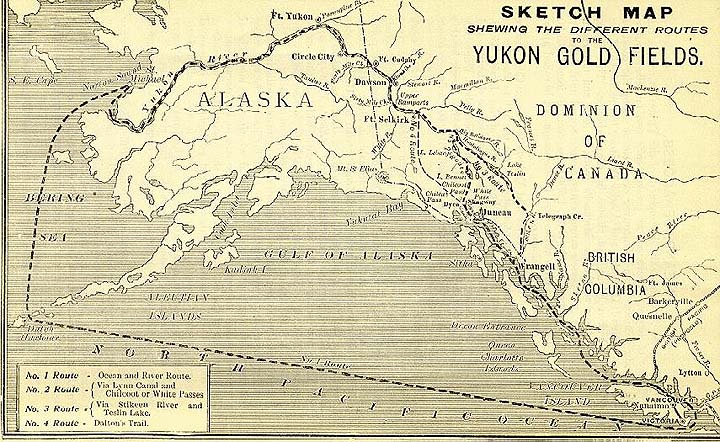
Route Map ~ Canada, High Commissioner. The Yukon District of Canada. London: Printed by McCorquodale and Co., Limited, 1897. 12.
Many routes led to the Klondike. All were difficult. The gold fields lay over 2,000 miles from Seattle, the closest major American city.
The most direct way was by boat to the Lynn Canal in southeastern Alaska, over White or Chilkoot Pass into Canada, and down the Yukon River. Alternate routes were by water via St. Michael, Alaska and the Yukon River, and by land through western Canada and Alaska.
Most stampeders who used alternate ways reached Dawson too late or not at all. The Yukon River froze in early fall and trapped water travelers. Those who went overland died from starvation, accidents, freezing and illness or became discouraged and went home.
Ship and train advertisements tempted stampeders. People took trains to a point of departure like Seattle or Vancouver where they bought goods and arranged travel north.

~ The Klondyker. Seattle: Alaska Intelligence Bureau, 1897.

~ Detail from The Klondyker. . .. Seattle: Alaska Intelligence Bureau, 1897.
Stampeders used guidebooks to plan their journey. For most people the Klondike was an unknown region – even its location was strange and remote. An outpouring of publications satisfied stampeders’ need for information. Some were credible, but bogus facts filled others. Many implied that everyone who looked could find gold.

~ Clements, J.I. Clements’ Guide to the Klondike. . .. Los Angeles: B. R. Baumgardt and Co., 1897.

~ Harris, A. C. Alaska and the Klondike Gold Fields. . .. Chicago: Monroe Book Co., 1897.
Continue to next section, “Outfitting for the Trip“